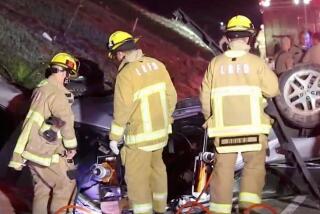Fatigue Cited in Screenwriter’s Fatal Crash
- Share via
PALMDALE — Disoriented from a dozen hours on the road, screenwriter Gary Devore was driving in the wrong direction on the Antelope Valley Freeway before plunging to his death in the California Aqueduct last year, according to the results of a California Highway Patrol investigation released Friday.
Investigators theorize that Devore, who vanished without a trace more than a year before a tip from an armchair sleuth led detectives to the screenwriter’s body, may have stopped to rest and then entered a freeway exit ramp instead of an onramp.
Devore was traveling northbound--away from his home in Carpinteria--but driving in the southbound lanes of the freeway immediately before the crash, said Ed Gomez, chief of the CHP’s Southern Division.
In that stretch of the freeway near Lancaster, Gomez said, there is a paved median leading to an unfenced drop-off into the aqueduct.
“He wouldn’t even have known anything was wrong until all of a sudden he was airborne,” Gomez said.
Devore’s fatigue, Gomez said, was evidenced by the fact he had misdialed his home phone number on several occasions as the hours wore on during his trip home from Santa Fe, N.M.
Coroner’s investigators were unable to determine a specific cause of death, because Devore’s body had been submerged for more than a year, Gomez said.
“It’s just an accident as far as we can see,” Gomez said. “There’s no indication of foul play.”
Gomez said Devore, 55, was probably driving about 70 mph at the time of the accident because his Ford Explorer had cleared an embankment sloping down to the aqueduct and landed in the middle of the channel. He said the front of the vehicle disintegrated and the roof caved in as it hit the water nose first.
“Hitting the water at [70 mph] is like hitting a brick wall. That would knock him out,” Gomez said. “We think he drowned.”
Gomez said Devore’s body was still secured by a seat belt when it was found by divers in July, suggesting the screenwriter made no effort to escape his sinking vehicle.
Investigators on the CHP’s Multi-Disciplinary Accident Investigation Team theorize the crash occurred between 1:20 and 1:35 a.m. June 28, 1997.
The theory is based on the fact that Devore’s cell phone, which he had been using frequently to call his wife, Wendy Oates-Devore, during the 900-mile drive, last registered as being on at 1:20 a.m., according to phone company records. Fifteen minutes later it did not register on the cell site nearest the area where he crashed.
“Either he turned it off or he was underwater,” Gomez said. “We suspect he was underwater.”
*
An aqueduct worker found the hood to Devore’s Explorer the day after the crash, but since there was no sign of an accident and such roadside discoveries are common, the worker paid little attention, Gomez said.
Intensive ground and air searches in the days and weeks after the crash, newspaper accounts and the eventual airing of a segment on the TV program “America’s Most Wanted” yielded no clues.
The break in the case came July 8 when a tip from Douglas Crawford, an unemployed lawyer in San Diego, led authorities to the submerged Explorer with Devore inside.
Crawford had read a newspaper article marking the one-year anniversary of Devore’s disappearance and said he was reminded of the case of an Orange County woman who vanished without a trace and was later found to have crashed into the California Aqueduct.
Crawford hypothesized that Devore had suffered a similar fate, and using information from newspaper articles about the disappearance set out to retrace Devore’s route.
When Crawford came to the area where the Antelope Valley Freeway crosses the aqueduct he got out of his car, crawled down the embankment and began to search the area. There, he said, he found debris from a white Explorer. He told authorities about his discovery, and divers found Devore’s body a short time later.
In the weeks following the discovery, Crawford said he feared he had become a suspect in the case. When homicide detectives from the Los Angeles County Sheriff’s Department sought to interview him, he declined and hired a criminal defense lawyer.
Crawford said Friday that he was vindicated by the CHP’s findings.
“I’ll be waiting by the phone for the cops to call me and thank me for doing all their work,” he said.
More to Read
Sign up for Essential California
The most important California stories and recommendations in your inbox every morning.
You may occasionally receive promotional content from the Los Angeles Times.










